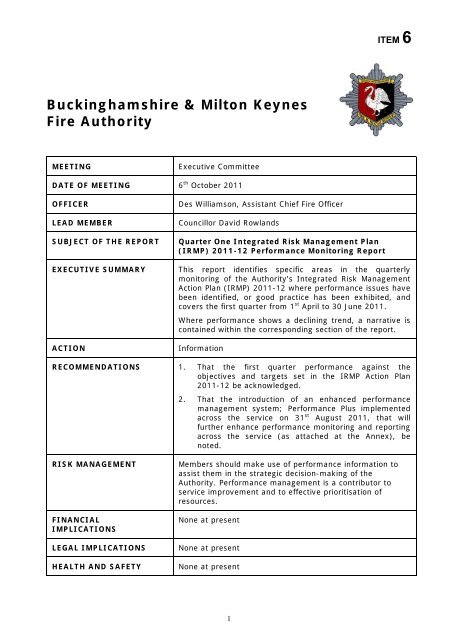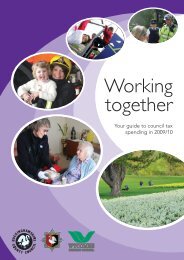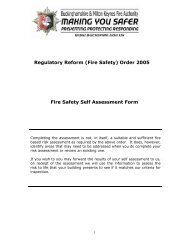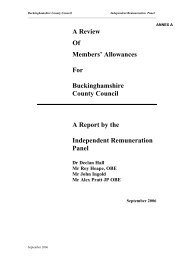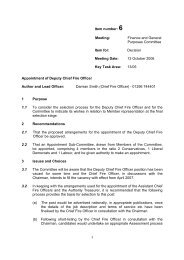Quarter One Integrated Risk Management Plan 2011-12 ...
Quarter One Integrated Risk Management Plan 2011-12 ...
Quarter One Integrated Risk Management Plan 2011-12 ...
Create successful ePaper yourself
Turn your PDF publications into a flip-book with our unique Google optimized e-Paper software.
Buckinghamshire & Milton Keynes<br />
Fire Authority<br />
MEETING Executive Committee<br />
DATE OF MEETING 6 th October <strong>2011</strong><br />
OFFICER Des Williamson, Assistant Chief Fire Officer<br />
LEAD MEMBER Councillor David Rowlands<br />
SUBJECT OF THE REPORT <strong>Quarter</strong> <strong>One</strong> <strong>Integrated</strong> <strong>Risk</strong> <strong>Management</strong> <strong>Plan</strong><br />
(IRMP) <strong>2011</strong>-<strong>12</strong> Performance Monitoring Report<br />
ITEM 6<br />
EXECUTIVE SUMMARY This report identifies specific areas in the quarterly<br />
monitoring of the Authority’s <strong>Integrated</strong> <strong>Risk</strong> <strong>Management</strong><br />
Action <strong>Plan</strong> (IRMP) <strong>2011</strong>-<strong>12</strong> where performance issues have<br />
been identified, or good practice has been exhibited, and<br />
covers the first quarter from 1 st April to 30 June <strong>2011</strong>.<br />
ACTION Information<br />
Where performance shows a declining trend, a narrative is<br />
contained within the corresponding section of the report.<br />
RECOMMENDATIONS 1. That the first quarter performance against the<br />
objectives and targets set in the IRMP Action <strong>Plan</strong><br />
<strong>2011</strong>-<strong>12</strong> be acknowledged.<br />
2. That the introduction of an enhanced performance<br />
management system; Performance Plus implemented<br />
across the service on 31 st August <strong>2011</strong>, that will<br />
further enhance performance monitoring and reporting<br />
across the service (as attached at the Annex), be<br />
noted.<br />
RISK MANAGEMENT Members should make use of performance information to<br />
assist them in the strategic decision-making of the<br />
Authority. Performance management is a contributor to<br />
service improvement and to effective prioritisation of<br />
resources.<br />
FINANCIAL<br />
IMPLICATIONS<br />
None at present<br />
LEGAL IMPLICATIONS None at present<br />
HEALTH AND SAFETY None at present<br />
1
<strong>Quarter</strong> <strong>One</strong> <strong>Integrated</strong> <strong>Risk</strong> <strong>Management</strong> <strong>Plan</strong> (IRMP) <strong>2011</strong>-<strong>12</strong> Performance Monitoring Report<br />
EQUALITY AND DIVERSITY Where applicable the limited resources we have are being<br />
targeted at the most vulnerable based upon collected<br />
demographic data. This demonstrates an equitable process<br />
based upon risk to all members of the community.<br />
USE OF RESOURCES<br />
PROVENANCE SECTION<br />
&<br />
BACKGROUND PAPERS<br />
There has been success in reducing incidents of death and<br />
injury in Road Traffic Collisions for young people through<br />
targeted activity in this group.<br />
Non-domestic properties are targeted according to their risk<br />
thus identifying the most vulnerable in the community.<br />
The potential issue of RDS recruitment and retention has<br />
been identified that may require further work.<br />
Performance monitoring<br />
Provision of timely performance monitoring information<br />
enabling feedback to members.<br />
Communication with stakeholders<br />
Informative and structured performance information<br />
incorporating stakeholder contributions.<br />
Background papers:<br />
• Corporate <strong>Plan</strong> <strong>2011</strong>-<strong>12</strong><br />
• <strong>2011</strong>-<strong>12</strong> IRMP (<strong>Integrated</strong> <strong>Risk</strong> <strong>Management</strong> <strong>Plan</strong>)<br />
Action <strong>Plan</strong><br />
APPENDICES Annex – high level view of performance for each of the<br />
measures outlined in the <strong>2011</strong>-<strong>12</strong> IRMP Action <strong>Plan</strong>.<br />
TIME REQUIRED 20 minutes<br />
REPORT ORIGINATOR AND<br />
CONTACT<br />
Executive Committee 6 th October <strong>2011</strong><br />
Toni D’Souza<br />
Manager – Performance & Intelligence Unit<br />
0<strong>12</strong>96 744444<br />
Page 2 of 6
<strong>Quarter</strong> <strong>One</strong> <strong>Integrated</strong> <strong>Risk</strong> <strong>Management</strong> <strong>Plan</strong> (IRMP) <strong>2011</strong>-<strong>12</strong> Performance Monitoring Report<br />
INTEGRATED RISK MANAGEMENT PLAN (IRMP) ACTION PLAN <strong>2011</strong>-<strong>12</strong><br />
PERFORMANCE MONITORING – 1 APRIL <strong>2011</strong> TO 30 June <strong>2011</strong><br />
1. Executive Summary<br />
1.1 This report focuses on performance monitoring against the strategic aims which form the<br />
<strong>2011</strong>-<strong>12</strong> Corporate <strong>Plan</strong> and provides a brief summary for each of the targets with<br />
further commentary upon those in exception.<br />
1.2 ANNEX A to this report provides a high level view of performance for each of the<br />
strategic aims outlined in the <strong>2011</strong>-<strong>12</strong> Corporate <strong>Plan</strong>. Performance is indicated by the<br />
RAG (Red Amber Green) status.The appendix, which contains detailed analysis, is further<br />
broken down against both strategic aims and a set of clearly defined associated<br />
priorities. These priorities allow us to target our limited resources where they will do the<br />
most good.<br />
1.3 In summary, of the 30 high level measures that support our strategic aims, eighteen (60<br />
per cent) are on target, four (13 per cent) are marginally off target, six (20 per cent) are<br />
off target and two (7 per cent) can not be reported against until the fourth quarter.<br />
2 STRATEGIC AIM ONE: Prevention<br />
Improving safety and helping to prevent fires and other incidents.<br />
2.1 Prevention 1: Reducing the risks to people from fire in the home<br />
2.1.1 Overall our success in reducing the risks to people from fire in the home are strongly<br />
supported by our corporate strategies which serve to target our resources to the persons<br />
who are most vulnerable to fire within the communities we serve. During the period 1 st<br />
April to 30 th June <strong>2011</strong>, we have reported 6 less accidental dwelling fire injuries<br />
compared to the same period last year (Target 1.2). A contributing factor is the number<br />
of dwelling fires attended where a working smoke alarm was present in 61 per cent of<br />
cases (Target 1.3).<br />
2.1.2 Of the four injuries reported between April and June, one was sustained in self contained<br />
sheltered housing, two in a council rented property (parent and child) and one privately<br />
rented, all three properties had a working smoke alarm fitted. Fortunately all four<br />
casualties sustained only “slight” injuries; two through attempting to fight the fire and<br />
two injured whilst escaping the fire (Target 1.2).<br />
2.1.3 During the first quarter of <strong>2011</strong>-<strong>12</strong>, there was a significant increase in the number of<br />
accidental dwelling fires (Target 1.1). During the 1 st quarter, 117 accidental dwelling<br />
fires were attended, an increase of 19 on the same period last year. This was<br />
particularly attributable to a number of cooking related fires, the majority of which were<br />
dealt with quickly and did not develop. Whilst representing a relatively large increase in<br />
percentage terms, in absolute terms the increase is relatively small due to the low baseline<br />
figures involved; essentially “the science of small numbers” across a large population<br />
sample: The slight increase in cooking related fires could be attributed to any number of<br />
social lifestyle changes brought about by the change in the economic climate caused by<br />
the recession: The trend will be used by stations to provide a variation to their<br />
community safety plans and to this end specific fire data relating to these type of<br />
incidents will be forwarded to station commanders for inclusion in their station planning<br />
processes.<br />
Executive Committee 6 th October <strong>2011</strong><br />
Page 3 of 6
<strong>Quarter</strong> <strong>One</strong> <strong>Integrated</strong> <strong>Risk</strong> <strong>Management</strong> <strong>Plan</strong> (IRMP) <strong>2011</strong>-<strong>12</strong> Performance Monitoring Report<br />
2.1.4 Intelligence gathered in 2010-11 and during the first quarter continues to indicate home<br />
owners are experiencing the highest number of accidental dwelling fires (66 fires in this<br />
category during the 1 st quarter <strong>2011</strong>-<strong>12</strong>). Looking further at the occupancy types<br />
suggests that the highest proportion associated with owner occupied properties are<br />
couples with dependant child/ren and lone persons under pensionable age. Furthermore,<br />
26 accidental dwelling fires were reported within the same period in rented<br />
council/housing association with highest proportion; lone persons over pensionable age<br />
and 21 in privately rented accommodation with the highest proportion; lone persons<br />
under pensionable age.<br />
2.1.5 The number of fires that have been confined to the room of origin (Target 1.4) and so<br />
have not spread to other areas of the building have declined to 82 per cent during the<br />
first quarter compared to 85 per cent for the same period last year. This measure use to<br />
form a part of the best value suite of indicators and much controversy exists amongst<br />
the Fire and Rescue service nationally in determining the reliability of this measure as an<br />
indicator of our performance. For example; determining the extent of fire spread where<br />
the seat of the fire was near or directly within the vicinity of a doorway. A review of<br />
Service Delivery related targets is due to take place to inform the consideration of more<br />
relevant targets for the future. The change of three percentage points does not indicate<br />
a significant change in performance terms and this measure will be further monitored to<br />
identify if this is sustained before recommending any changes in current practice.<br />
2.1.6 The new Home Safety Check (HSC) administration and reporting procedure,<br />
implemented recently, will facilitate a more effective method of controlling this function.<br />
Stations now have local statistics and details of various social groups including their<br />
specific vulnerability to fire. This will aid targeting of HSCs to the most vulnerable<br />
persons. It is expected that the performance in monitoring the number of HSCs<br />
undertaken (Target 1.6) will improve dramatically in the next quarter and will have a<br />
positive impact on reducing the number of accidental dwelling fires (Target 1.1).<br />
2.2 Prevention 2: Working effectively with partners on education programmes<br />
which reduce risks to people from accidental and deliberate fires.<br />
2.2.1 Overall the number of primary fires in vehicles and secondary fires in buildings are<br />
declining (Targets 4.3b, 4.4a and 4.4b) aside from primary fires in buildings (excluding<br />
dwellings, Target 4.3a) which is marginally off the performance level set. These results<br />
on the surface, all reflect excellent performance of our service. However, these targets<br />
also reflect the “science of small numbers” compared to population group.<br />
Consequently, it follows that some caution is advised at this stage in seeking to attribute<br />
success or failure of our activity within these areas.<br />
2.3 Prevention 3: Working effectively with partners to reduce the number of road<br />
traffic collisions targeting young people and those most at risk.<br />
2.3.1 Once again this appears a very successful area and one to be celebrated (Target 3.1).<br />
The number reported killed and seriously injured during the first period of <strong>2011</strong>-<strong>12</strong> was<br />
61; that is a reduction of 14 compared to the same period last year. The systems that<br />
the service has in place for the education of young drivers, motor cycle riders and young<br />
pedestrians is well structured, well managed and offered in a very effective manner to all<br />
persons in these categories.<br />
2.4 Prevention 4: Reducing Anti-social behaviour and improving social well-being.<br />
2.4.1 Whilst the number of malicious false alarms have increased (Target 4.1) when compared<br />
to the same period last year, the number that we have attended has reduced (Target<br />
4.2). Our non attendance to malicious false alarms reflects an element of professional<br />
performance in respect of our control staff utilising call challenging methods to filter the<br />
extent of call validity.<br />
2.4.2 The number of malicious false alarms received (Target 4.1) has not achieved target.<br />
Going forward, more analysis and work will be required to address this trend.<br />
Executive Committee 6 th October <strong>2011</strong><br />
Page 4 of 6
<strong>Quarter</strong> <strong>One</strong> <strong>Integrated</strong> <strong>Risk</strong> <strong>Management</strong> <strong>Plan</strong> (IRMP) <strong>2011</strong>-<strong>12</strong> Performance Monitoring Report<br />
3. STRATEGIC AIM TWO: Protection<br />
Protecting public buildings and workplaces from fire<br />
3.1 Protection 1: Maintaining risk based inspection and enforcing fire safety<br />
legislation.<br />
3.1.1 Target 2.1, implementing a risk based audit programme for the common areas and<br />
private living accommodation of 75 per cent of the sheltered housing premises within the<br />
area we serve has not been populated and therefore has not provided a performance<br />
indicator as yet. Note that; Enforcement of the Regulatory Reform (Fire Safety) order<br />
2005, does not specifically reduce the chance of a fire occurring, but seeks to make<br />
‘relevant persons’ safe from fire.<br />
3.1.2 Successfully defending appeals against alteration, enforcement or prohibition notices<br />
issued under the Regulatory Reform (Fire Safety) Order 2005 (Target 2.5) is a suitable<br />
indicator for our performance. It reflects the technical and practical ability of our<br />
auditing officers, the effectiveness of our monitoring systems and the skill of our<br />
managers. Currently, the indicator shows that we are extremely effective in this respect,<br />
in relation to our Protection activity.<br />
3.2 Protection 2: Providing education and advice on fire protection measures.<br />
3.2.1 Undertaking audits within 90 per cent of high-risk non-domestic properties within the<br />
month they fall due (Target 2.4) is a good indicator of our ability to manage a risk based<br />
enforcement programme. It is dependant on us maintaining our capacity to undertake<br />
audits but it relies predominantly on the ability of our protection managers to direct work<br />
flow effectively. At the current time, we are performing within the parameters set by the<br />
indicator. This should be recognised as exceptional given the recent effect of the<br />
restructure changes and the consequent reduction in auditing capacity.<br />
4. STRATEGIC AIM THREE: Response<br />
Intervening and responding to fires and other incidents<br />
4.1 Response: Intervening and responding to fires and other incidents<br />
4.1.1 The number of false alarms caused by automatic fire detection equipment (Target 2.2) is<br />
marginally off target during the first quarter, though the number of repeat calls to<br />
automatic fire alarms (Target 2.3) is well within target. These performance criteria<br />
themselves are a good indicator of the actual effect that we can have on unwanted fire<br />
signals as they take account of our day to day activity. They show that our interactions<br />
are risk based and our method of rectification is effective. This should be considered in<br />
light of the fact that we attend all calls for assistance caused as a consequence of the<br />
operation of automatic fire alarms. This is as opposed to some services that choose to<br />
opt for non-attendance to automatic fire alarms that emanate from specific types of<br />
premises. This method of filtering has very little risk validation and is likely to place<br />
organisations who choose to pursue it, at increased operational risk. This course of<br />
action can dramatically reduce attendance to unwanted fire signals and subsequently<br />
improve performance, albeit under false pretences. The degree of fluctuation from the<br />
target can reasonably be attributed to seasonal variation: Historically there is a definite<br />
increase in the number of fire alarm actuations caused by temperature changes and<br />
thrips entering detecting devices, over the spring and summer months. (Thrips are small<br />
bugs which are carried along by airstreams). This effect is likely to tail off as we enter<br />
the last two quarters of the year. Given that currently the effect has only marginally<br />
moved our performance off target it is reasonable to expect this indicator to come in on<br />
target across the fiscal year.<br />
Executive Committee 6 th October <strong>2011</strong><br />
Page 5 of 6
<strong>Quarter</strong> <strong>One</strong> <strong>Integrated</strong> <strong>Risk</strong> <strong>Management</strong> <strong>Plan</strong> (IRMP) <strong>2011</strong>-<strong>12</strong> Performance Monitoring Report<br />
4.1.2 Availability of whole-time pumps continues positively to within 0.7 per cent of our target<br />
(Target 5.4).<br />
4.1.3 During the first quarter the overall availability of our retained pumping appliances<br />
(Target 5.5) has slipped to 73 per cent against a target of 95 per cent. The decline in<br />
availability is largely seasonal and the 2 nd quarter of the year is likely to show lower<br />
performance due to increased leave during the summer months. We continue to face<br />
ongoing challenges to recruit and retain RDS staff. Overall difference between target<br />
and actual is accounted by the Monday to Friday daytime lack of availability, where<br />
night-time and weekend availability is very good. RDS remains the most cost effective<br />
means of providing fire cover, particularly in Authority areas such as our own. A review<br />
in to the way we provide RDS staff is planned for next year. This will need to identify<br />
some new and innovative methodologies for the provision of RDS staff in certain<br />
locations. Princes Risborough, Aylesbury and Amersham and Winslow have all exceeded<br />
the 95% target in 2010/11, with Marlow, Chesham and Brill all demonstrating very<br />
positive progress in availability during this time. The potential retirement profile of staff<br />
at some of our most consistently best performing RDS stations is being examined, and it<br />
is likely that pro active action will need to taken at some of these locations to ensure<br />
that the integration of new staff is achieved in such a manner that maintains high levels<br />
of performance.<br />
4.1.4 We continue to maintain a fully operational and resilient local mobilising and control<br />
room capability (Target 5.7).<br />
4.2 Response 1: Supporting a safe and effective response to incidents<br />
4.2.1 The service has not had any work-related deaths or serious injuries to our staff. The<br />
service takes Health and Safety very seriously and spent a considerable amount of time<br />
during the previous year encouraging hazard reporting to prevent accidents before they<br />
occur. Breathing apparatus and driver training has undergone considerable review over<br />
the past eighteen months and a brigade wide training needs analysis will be conducted<br />
shortly (Target 5.1).<br />
4.3 Response 2: Providing an effective response to fires, RTCs and other incidents.<br />
4.3.1 Our attendance to road traffic collisions where people are confirmed trapped is<br />
marginally off target (Target 3.2), with our attendance in 10 minutes being made on 68<br />
per cent of occasions against a target of 75 per cent. Our attendance within 20 minutes<br />
on 98 per cent of occasions is marginally off target by 0.7 per cent. Further<br />
investigation and identification of required corrective action will be undertaken to<br />
address under-performance.<br />
4.3.2 Despite our under-performance reported against Target 3.2 above, overall we are<br />
exceeding our ten and twenty minute response times. During the first period April to<br />
June <strong>2011</strong>, we exceeded our set standards; 78.9 per cent in 10 minutes (target 75 per<br />
cent) and 98.9 per cent in 20 minutes (target 98 per cent), we will continue to strive<br />
towards exceeding these (Target 5.2).<br />
4.3.3 The pre-determined attendance of all pumping appliances was met on 88.4 per cent of<br />
occasions, exceeding the target of 85 per cent (Target 5.3).<br />
Executive Committee 6 th October <strong>2011</strong><br />
Page 6 of 6


